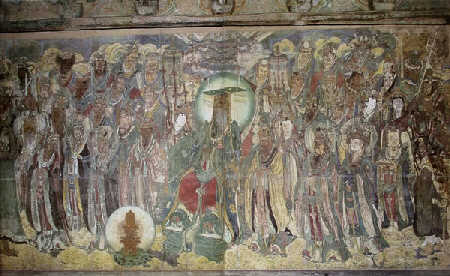Most of the Dunhuang Murals depict Buddhist stories. For example, in No. 257 Grotto, there is a mural drawn in the Northern Wei Dynasty depicting the Buddhist story "Nine-Color Deer Script." The Nine-color Deer came upon a river and saved Diao Da who was drowning. Later the Queen urged the King to skin the Nine-color Deer to make a garment for her. When the King's soldiers were searching for the Nine-color Deer, Diao Da betrayed the Deer's whereabouts. Diao's ingratitude for the Deer's kindness was punished; the Nine-Color Deer was allowed by the King to go back to the mountain. The story is painted in nine scenes, with most animal and human figures drawn in profile; no wrinkling and rubbing skills were used to paint the background mountains and rivers. The strokes of the painting are of great strength, the colors are bright, and the shapes of the figures are decorative. Deep colors are used to draw the outlines, and the color becomes lighter in the middle section. The brightest parts were pointed with white powders to make it look more three-dimensional.

The Dunhuang Murals contain rich designs of Buddhas, deities, ghosts, animals, mountains, rivers, architecture and a few decorative patterns. It is a splendid treasure of Buddhist art. The murals present the painting styles and features of different dynasties, imitating the West Regions at first but drawing more on the Han styles as time went on. In the Dunhuang Murals, we can see directly the development of mural art over ten dynasties and get rich information about many aspects of Chinese culture and history.
 The Yongle Palace Mural
The Yongle Palace Mural

Click here to view more Yongle Palace Murals
The Yongle Palace Mural in Pinglu County of Shanxi Province on the northern bank of the Yellow River is a treasure of Chinese murals.
The Sanqing Hall is the main hall of the Yongle Palace. Paintings were drawn inside and outside its alcoves and on the walls. The mural in the hall covers a total space of 403.34 square meters, and it decorates the hall like a relief sculpture. Records show the mural was drawn in 1325 during the Yuan Dynasty, and it has retained its original beauty even after the wear-and-tear of several hundred years.
